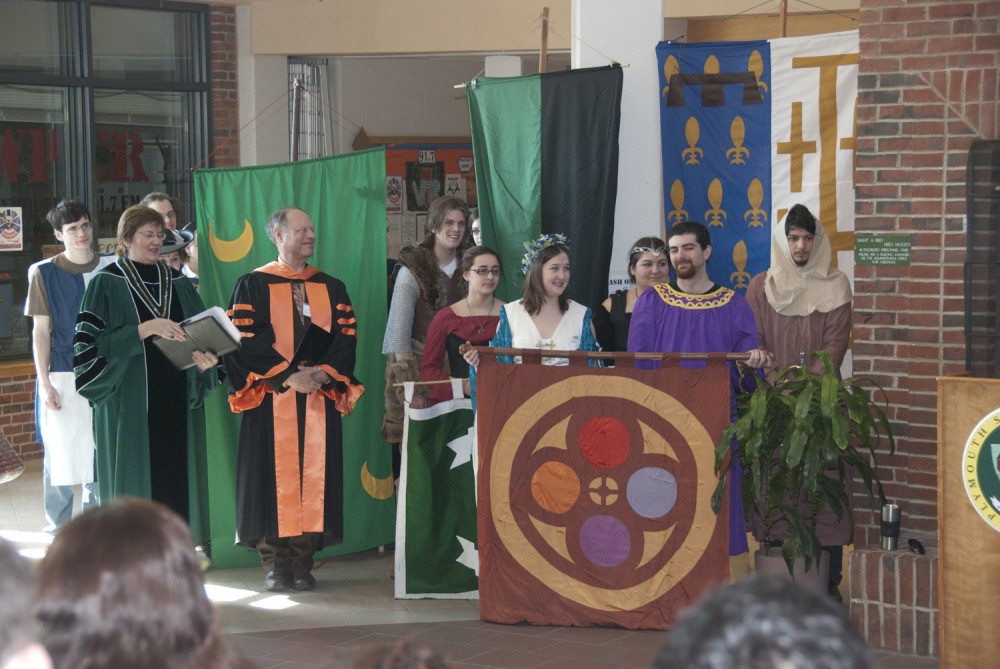 Post Classifieds
Post Classifieds
A Wondrous Weekend of Entertainment and Celebration at Plymouth's 32nd Annual Medieval and Renaissan
On April 15th and 16th, Plymouth State University held its 32nd annual Medieval and Renaissance Forum, with this year's theme being Love, Friendship, and Marriage. The two-day forum started with an opening ceremony on Friday at 9 a.m. in front of Rounds Hall. The session proceeded through the Hartman Union Building where Karolyn Kinane, the forum director and English professor here at Plymouth State, made opening remarks. Following Kinane was a reading from Chaucer's Canterbury Tales, welcoming poems and group singing accompanied with Mike DiTommaso on trumpet.
There were four sessions of scholarly conferences throughout the day on Friday. Most of these conferences took place in Rounds Hall and featured between two and four speakers. Each speaker presented a scholarly paper that focused on some aspect of love, friendship, and/or marriage and its significance in Medieval life and culture.
One session, Love, Marriage, and Friendship: Ideal and Reality, hosted Jerimiah Bergstrom from Lesley College reading his paper Marital Relationships in the York Mystery Plays: Procula, Pilate, and Medieval Misogyny. Throughout his reading, Bergstrom touched upon the differences between modern English and the biblical stories they derived from. Character roles were a big point throughout his paper; it was claimed that female biblical figures such as Procula and Eve were portrayed as errant and comical, and had been stripped of their ‘big roles' in a biblical sense. 15th century England characters also lacked biblical reference, and the spotlight then turned to a domestic setting, which focused on a traditional husband and wife relationship. The reenactments in the York Mystery plays include some reference to the Old and New Testament while incorporating both comedic and tragic elements to grasp reality from different time periods.
Another reading during that session hosted Richard Burley of Boston College and his paper on Prayers for the Dearly Departed: Visitations from Ghostly Spouses in Post-Conquest Medieval England. Burley's works derived much from Latin/Old French, which required a translation handout in order for full comprehension of his session. Some main points included the relationship between a living spouse and the ghost or spirit of that spouse's departed, the connections between life and death, and accepting each spirit as an individual. Burley explained the reasoning behind a male spouse and having two wives; the connection was made between having a physical wife while keeping social interaction between those who may live in Purgatory. There was also explanation behind the push of female sexuality and their growing interest in love.
Session 3 late Friday afternoon held another conference, "With this Ring": Marriage Rituals, Social Status and Education in Fifteenth-Century Florence. Here we got to explore the Workshop Conventions and Inventions in the Creation of Cassone Iconography: The Journey of the Queen Sheba by Beall Fofana of Assumption College. Fofana included works from Apollonio di Giovanni and Marco del Buono de Marco. Their works were most common on marital chests, which were used as permanent gifts to the bride and groom. Chests were usually present in the bedroom for decoration or used as a table or backrest. However, these chests did more than decorate the abode of newlyweds; rather they told a continuous narrative. Fofana's essay referenced the Old Testament as well as the Golden Legend. The journey of Queen Sheba is depicted on the chests and her journey to seek King Solomon. Queen Sheba and her entourage are shown heavily decorated in gold and colors of royalty to deliver her riches of 120 talents of gold, spices, and precious stones. Symbolism was a main theme throughout Fofana's session. She explained the artwork as a part of religious events going on in Florence around 1439. Queen Sheba is represented as the East, while King Solomon represents the West. Her journey to seek King Solomon symbolizes the reconciliation of the churches in the East and West.
Those are only some of the many sessions held throughout the entire forum. This annual forum attracts scholars, students and professors from all over to express their knowledge and interest on Medieval Renaissance. The Forum was also decorated with hands-on demonstrations, including a letterpress session, a live chess match, and a longbow archery demonstration. On Saturday, the Forum was wrapped up with a medieval feast and Renaissance dance in Prospect Hall. Many enjoyed the event in full costume. The 32nd Medieval Forum was once again successful in its efforts to color and enliven our understanding and knowledge of a most enchanting historical period.
Get Top Stories Delivered Weekly
Recent theclockonline News Articles
Discuss This Article
MOST POPULAR THECLOCKONLINE

Campton Elementary School 8th Grade Silent Auction & Spaghetti Dinner By Rebecca Tgibedes

Will You? By Isabelle Elsasser

Summer in the Sunflowers By Emily Holleran

Student Spotlight: Sabrina Siegel By Justine Walsh
GET TOP STORIES DELIVERED WEEKLY
FOLLOW OUR NEWSPAPER
LATEST THECLOCKONLINE NEWS
RECENT THECLOCKONLINE CLASSIFIEDS
OUTSIDE THE LINES
- Moving Resources For Military Families
- Historic Agreement Signed By Red Cross and Armed Forces
- Salonpas® Brand Stands the Test of Time
- Tips to “Yard Your Way” This Spring
- Upgraded Upstate Power Grid Will Deliver a Smarter,...
- A Story To Sing About
- The Gap in Gum Care: Why Caring For Your Teeth’s F...
- Top Tips for Signature Scents and Better-Smelling Laundry
- A Dog Trainer’s Top Tips to Support Pets Through Life S...
- Clear the Air of Indoor Pollutants This Spring
FROM AROUND THE WEB
- BookTrib's Bites: Four Captivating Spring Reads
- Moms Kick Back with Mamaritas
- Generac Urges Americans to Prepare for Power Outages Early
- Youth Apprenticeship Week Spotlights Opportunities
- New Expo Showcases AI Innovation
- Self-Care and Mental Health Tips for Caregivers
- Adventure Awaits: Discover the Playset that Brings...
- Need Auto Glass Repair? Don’t Despair
- Pioneering Fast and Affordable Broadband for the Underserved
- 7 Reasons Renting an RV Should Be On Every Family’s S...
COLLEGE PRESS RELEASES
- Guidenar Launches New Career Test for Gen Z
- GotIt! Education Offers MathGPT Free to All State & Community Colleges
- Shoff Promotions Comic Book & Sports Card Show
- Semiconductor Research Corp unveils 2024 Research Call, $13.8M Funding
- Charles River Associates Opens Second Scholarship Cycle, Expands to the UK






